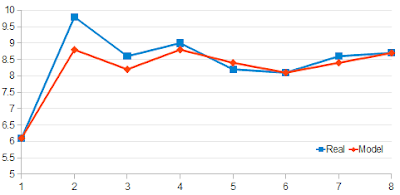Simple Harmonic Sleep
28 Jan 2012 So I started using SleepBot Tracker to track my sleep. This is what it's looking like so farBasically, I'm averaging about 8 hours, except on those two days near the start where I had to get up early for exams.
Now, being a physics student, the graph reminded me of that for damped simple harmonic motion (starting from 20/01, ignoring the first 3 points). And being a crazy person, I decided to try and model my sleep as such.
So what's simple harmonic motion?
Simple harmonic motion is a type of periodic motion with a restoring force directly proportional to the the system's displacement from equilibrium.
For example, a pendulum is a simple harmonic oscillator - it has periodic motion, its equilibrium is the lowest point of the swing, and the restoring force is gravity.
Now, one could argue that sleep is SHM-like - we have some typical sleep length (equilibrium), and if we get too little sleep, then we'll tend to sleep more in response, and vice versa (restoring force). But it's a dubious analogy at best.
A damped harmonic oscillator is one with damping, which tends to reduce the amplitude of oscillations. So, like air resistance in the case of the pendulum, which eventually causes it to stop swinging.
I'm not sure what the sleep-based analogy for damping would be.
There's a standard equation for defining a (weakly) damped harmonic oscillator. It looks like this:
Where:- A0 is the initial displacement, the e bit is the decaying term, gamma is the damping coefficient (which determines how quickly the oscillations decay), cos() is the oscillating term, omega is the (damped) frequency of oscillation, t is time (in days), phi is the phase shift, and C is the equilibrium amplitude.
So working out the variables from the data, the model equation for my sleep looks something like this
And the graph looks like this
And to prove I'm not entirely crazy, here are the real values and the model values plotted together
Not a bad fit, right? [error 0.19]
In fact, you might notice the real data is still oscillating a little. But the equation outlined above tends to a constant amplitude of 8.3 (no more oscillations).
To account for this, we could add a baseline oscillation term
And fitting the data again, here's what the graph looks like
Arguably, a slightly better fit. [error 0.16]
So yeah. Basically, I'm procrastinating..
Oatzy.
[Just gotta be careful not to hit resonant sleepquency]






